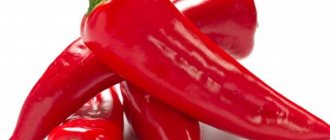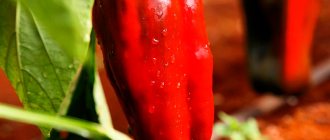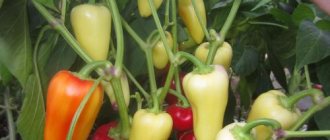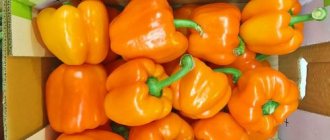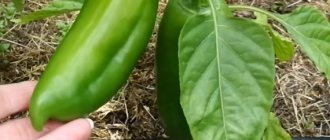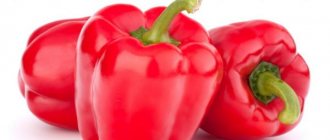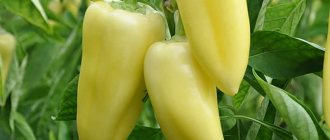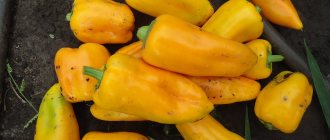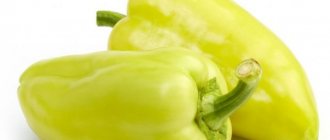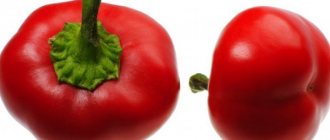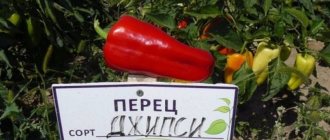What kind of pepper is this
Ombrone pepper is a hybrid of red sweet peppers . The seed producer is the Japanese company Sakata, the hybrid is listed in the State Register of the Russian Federation.
Suitable for growing in protected and open ground. Fruits are able to set even at low temperatures.
Hybrid f1
Ombrone pepper has a medium-early ripening period . It is unpretentious in care and tolerates adverse environmental factors and transportation well.
Characteristics and description
The bush is powerful, semi-spreading, from high to medium . The foliage is medium-sized, wrinkled, dark green to green in color. Ripening begins 70-75 days after planting the seedlings in the ground.
Distinctive features
Fruits more abundantly in a greenhouse than in open ground . It is distinguished by large fruits and a balanced, bright taste that is preserved even after freezing. The fruit is especially good in fresh salads and preserves.
Reference. Pepper can bear fruit throughout the season, provided that the growing technology is followed. Suitable for breeding in central Russia at low temperatures.
Fruit characteristics, yield
Pepper fruits have a cuboidal, elongated, three- to four-chambered shape . The tip is blunt, the wall thickness is 8 mm. The length of the vegetable reaches 15-18 cm, weight - 300-400 g. Peppers taste sweet, juicy, without bitterness. When the pepper ripens, it turns bright red in color.
Ombrone pepper is characterized by high yield - up to 5.5-6 kg per 1 m² . Feels good in the middle zone.
Pepper: varieties for greenhouses and recommendations for choosing the right type
Many gardeners practice growing sweet peppers for their own needs, for commercial purposes. It has long been noted that this heat-loving crop grows best in our latitudes and produces abundant harvests when grown in a greenhouse.
This does not mean that by planting any variety of sweet pepper in a greenhouse, you can count on the brightest prospects for obtaining a large number of marketable fruits with excellent taste. Breeders develop special varieties adapted to growing conditions in protected soil.
Recommendations for choosing greenhouse pepper varieties
To choose the best pepper varieties for a polycarbonate greenhouse, you should consider a number of factors. This will allow you to subsequently avoid disappointments associated with problems with caring for plants, incorrectly determined harvest dates, disappointed expectations due to receiving fruits of the wrong shape, size, color, taste, etc.
When purchasing pepper seeds, you definitely need to find out whether the variety you are interested in is suitable for greenhouse cultivation (in a permanent greenhouse or under a film cover).
Ripening time
You should definitely decide on the desired ripening time for bell peppers, since seeds are available for sale: early, mid-early, and late-yielding varieties. Experienced gardeners advise purchasing seeds of crops that ripen at different times in order to be able to enjoy your favorite vegetables for as long as possible.
It is also advisable to take into account the fact that at the end of the season it is justified to transplant plants of late varieties into pots for moving into the house. This ensures the bushes bear fruit until mid-winter.
Height, compactness of plants
It is imperative to obtain information about the height and compactness of varietal bushes. Owners of permanent greenhouse structures with large areas often give preference to tall, spreading plants. If it is possible to allocate only a small space for a greenhouse, it makes sense to choose low-growing, compact varieties.
Disease resistance
It is advisable to ask neighboring gardeners who have successful experience in growing peppers in greenhouses, what diseases is the crop susceptible to in local climatic conditions? This will allow you to select hybrids, for example, Dutch ones, that are resistant to specific diseases.
Lighting conditions, climatic features
For good growth and fruiting, peppers need a sufficient amount of light energy. The final choice of greenhouse pepper varieties should be made based on the lighting conditions of the site and the climatic characteristics of your region.
The presence of a capital heated greenhouse will greatly simplify the decision-making process in favor of suitable varieties of pepper, since in this case, productivity indicators, presentation, and taste of the fruit will be put to the fore.
Popular varieties of greenhouse peppers
When visiting a retail outlet that sells sweet pepper seeds, an inexperienced gardener may become confused due to the abundance of bags offered for sale.
Standing at the counter, reading annotations for the varieties being sold is not very convenient. Following the advice of sellers who are far from agriculture is also not the best option. It makes sense to study pepper varieties for greenhouses in advance, so as not to make a mistake in your choice. Below is an overview of the most popular varieties of greenhouse peppers, which have been approved by many experienced gardeners.
Denis
Denis will delight you with sweet, juicy peppers due to their early ripening (80 - 90 days). The hybrid has excellent resistance to tobacco mosaic. As a rule, the fruits of the Denis variety are eaten fresh.
As the varietal bushes grow, they reach a height of 70 cm. The fruits of the hybrid are characterized by the following parameters: weight up to 400 grams, wall thickness of about 9 mm, length 10 - 18 cm. Ripe peppers acquire a cuboid shape and a rich red color.
Lotta F1
Early ripening pepper Lotta F1 (95 - 105 days required for ripening) has proven itself well in film greenhouses. Its yield indicators are very respectable (up to 8.5 kg / m2). Gardeners are happy to grow this strong plant with cone-shaped pyramidal fruits 7 - 14 cm long, weighing 150 - 160 grams.
Technically mature fruits of Lotta F1 pepper with walls up to 7 mm thick have a light green color; as they ripen completely, they become red, smooth, glossy, and dense. The hybrid demonstrates resistance to bacterial black spot and tobacco mosaic. The fruits are used universally.
Novogoshary
Mid-early pepper from Novy Goshary is valued for its increased transportability and good preservation of fruits. Many summer residents give favorable reviews of Novoshary pepper. The fruits of the variety have tender, juicy, sweet pulp.
Varietal bushes are semi-spreading, standard, their height can reach half a meter. Fruits weighing about 90 - 140 grams are characterized by a round, somewhat flattened shape. As they ripen, the green color of the fruit changes to red. The walls of the pepper are thick (8 - 11 mm). The duration of the fruiting period is up to one and a half months.
Ombrone
It is not by chance that gardeners give forest reviews of Ombrone pepper. This mid-early hybrid is characterized by impressive yields. Varietal plants are strong, compact, resistant to leaf spot, cucumber mosaic, and fusarium.
The fruits of Ombrone pepper are large in size (9 x 14 cm), with a solid weight of 250 - 300 g. four-chamber cuboid shape. Fully ripened peppers turn deep red.
The gardener will not have problems with transportation and storage of Ombrone pepper fruits, which are very resistant to cracking.
Big gold
The Big Gold pepper deservedly received its name. Its ripe large fruits, weighing 200 - 220 grams, delight with their dark orange rich color. The yield of pepper, ripening in the mid-early period under film cover, is quite impressive: up to 7 kg / sq.m.
The taste and presentation of the fruit are not satisfactory. Semi-spreading pepper bushes reach an average height in growth, 3-4 nests with drooping fruits are formed on them. The shape of the fruit is prism-shaped, the surface is glossy, the walls are up to 8 mm thick.
Kubyshka
Early ripening pepper Kubyshka is considered one of the most vitamin-rich varieties, and a new one at that. Spreading bushes grow quite tall (about 1 m), and 3–4 nests are formed on them. The yield of pepper grown indoors reaches 6 kg/sq.m.
Varietal fruits are drooping, cylindrical in shape, have a highly glossy surface, dark green color (in the technical stage), dark red (in the biological stage). Ripe fruits with medium-thick walls weigh about 250 grams and have an excellent taste.
Topolin
The mid-early Topolin pepper is a slightly spreading, semi-standard plant that reaches average growth rates. The fruits of this variety have a conical shape, quite large sizes (length up to 12 cm, diameter up to 8 cm), weighing 100 - 160 g.
Technically mature peppers are light green in color; fully ripened fruits acquire a dark red color. Gardeners note the variety’s resistance to verticillium.
Tevere F1
Early Tevere F1 pepper has many advantages: good preservation, wonderful taste of bright yellow fruits. The varietal plant is strong, compact, low.
The fruits are characterized by: weight 240 - 300 g, length 12 - 16 cm, diameter 9 - 13 cm, presence of 3 - 4 chambers, walls 8 - 11 mm thick. The fruits have a cone shape, a dense, glossy surface. When giving reviews of Tevere F1 pepper, gardeners focus on the excellent fruit set of this hybrid.
Red Baron
Sweet pepper Red Baron ripens in the early stages (96 - 102 days) and reaches an average height in growth. Summer residents note the high yields of the Red Baron variety: 5.8 - 10 kg/sq.m, resistance to tobacco mosaic infection.
The fruits are located on the bushes in a drooping position, have a cuboid shape, a glossy surface, and at the stage of final ripeness they become rich red. The weight of the fruit is 180 - 230 g, the wall thickness reaches 8 mm.
Winnie the Pooh
It’s not for nothing that homeowners give flattering reviews about Winnie the Pooh pepper, since this variety is successfully grown in greenhouses in the Northern, Central, and Volga-Vyatka regions. The hybrid demonstrates excellent resistance to blossom end rot and tobacco mosaic.
Early ripening fruits of Winnie the Pooh pepper (ripening period 107 - 111 days) have a cone-shaped shape, weak longitudinal ribbing, and a pointed apex. The varietal bushes are low (25 - 30 cm), compact with a “bouquet” arrangement of fruits weighing 48 g. The yield of the variety is 1.6 - 1.8 kg / sq.m.
Love
Early pepper Lyubov has earned praise due to its high yield and ability to withstand stressful conditions. The culture is resistant to TMV and has good transportability. The plant is medium in height, semi-spreading, with semi-drooping fruits, number of nests 3 pcs.
The shape of the fruit is cone-shaped, their surface has a strong gloss. The technically mature light green color changes to dark red in the process of full ripening of the fruit. Fruit weight indicators are in the range of 130 - 150 g, wall thickness is 5 - 5.6 mm. Fruit dimensions 12 x 6 cm.
Flamenco
By planting Flamenco pepper, the gardener will subsequently receive a bountiful harvest of large, cube-shaped, thick-walled fruits. This early variety is resistant to tobacco mosaic and has the ability to set fruit in very unfavorable conditions.
Varietal peppers are perfectly stored and transported. It is practiced to grow plants in film, glass greenhouses. Ripe fruits measure 10 x 14 cm and have a bright red, eye-catching color.
Chocolate
The mid-early chocolate pepper got its name because the ripe fruits acquire a characteristic gloss and original red-brown color. This plant is grown not only in greenhouse conditions, but also at home in pots.
Varietal fruits are actively used in home canning, for preparing salads, and lecho. The bushes of the crop are compact and medium-sized. The shape of the fruit is truncated-cylindrical, weight 120 - 130 g. It is quite possible to collect 2 - 2.6 kg of pepper from one plant.
Stanley
Growing Stanley peppers in a film greenhouse is very simple. The hybrid is considered mid-early, high-yielding. Pepper bushes reach medium height and are covered with drooping, cube-shaped fruits.
Glossy varietal fruits as they ripen are characterized by a change in color from green to dark red. The fruits weigh 75 - 130 g, peel thickness 8 - 10 mm. The plant is resistant to TMV.
Blot
The wonderful Klyaksa pepper evokes admiration for its non-trivial color. The color of technically ripe fruits is purple; finally ripe peppers become deep red.
The crop is characterized by medium ripening periods. Varietal bushes grow semi-spreading and reach medium height. Varietal fruits weigh about 120 grams and have walls 6 mm thick. The yield of the variety is 3.5 kg/sq.m.
Montero
Early ripening Montero pepper can be grown in any greenhouse.
The plant reaches a height of 1 m. Its fruits have a prismatic shape, bright red color, and weigh 240 - 260 g. The culture is noted to be resistant to tobacco mosaic infection. Yield indicators are 7 - 16 kg / sq.m.
Sweetie
Early ripening pepper Candy is valued for its original shape, excellent taste of fruits, and good yield (up to 3 kg / sq.m.). Low-growing bushes have a closed shape. The fruits, weighing 40 - 50 g, are located horizontally. The shape of the fruit is semi-round, slightly wavy, their surface is glossy. Light green fruits (stage of technical ripeness) become red upon final ripening.
Having decided on the optimal varieties of pepper for greenhouses in the Moscow region, you should also study the methods of growing the crop in closed ground conditions in order to then apply the knowledge in practice.
As you gain experience, you can count on getting high yields.
This will make it possible not only to diversify the diet of household members with the help of these healthy vegetables, but also, over time, to receive a good profit from the sale of greenhouse peppers.
Source: https://LetnyayaDacha.ru/ogorod/ovoshhi/perets/raznovidnosti-sortov/perets-sorta-dlya-teplits-i-rekomendatsii-po-vyboru-podhodyashhego-vida.html
Preparation for cultivation
To fully enjoy the taste and high yield of this pepper, you need to grow strong seedlings and provide them with proper care.
Soil preparation
It is better to prepare the soil for vegetables in the fall . You will need a mixture of turf soil, peat, humus with the addition of wood ash. 5-7 days before sowing the seeds, the prepared soil is left in a warm room to warm up. The soil is disinfected with a solution of potassium permanganate, a fungicide, and then dried.
Growing seedlings
After the emergence of seedlings, the seedlings are transferred to a bright place and the temperature is maintained at 16-18 °C, which is increased during the week to 25 °C during the day and 15 °C at night. Normal development of seedlings is ensured with a 12-hour daylight hours and additional lighting in cloudy times.
Important! To avoid rot and death of still immature plants, watering is carried out with warm water once every 1-2 days.
The soil is periodically loosened to a depth of 3-5 cm , excess water is drained from the trays, providing air access to the roots. The first application of fertilizing is carried out after the appearance of 2-3 leaves with a 1% solution of complex fertilizer, then fertilized every 2 weeks.
Planting pepper
If the seeds were planted in the ground, 20-30 days after germination they are planted by reducing the length of the central root rod by 1 cm. Then the plants are placed in cups or cassettes. If sowing was carried out in cells, they do not dive, but transfer the sprouts into larger pots. Picked sprouts are planted in the ground after 60-70 days, grown in cups - after 50 days.
Bushes ready for planting have 5-8 true leaves , no more than 2 ovaries, and the plant height is at least 15-20 cm.
Planting is carried out when the threat of night frosts has passed , the air temperature is 16-18 °C, and the soil temperature is 12-15 °C. Evening time is more suitable, when direct sunlight cannot harm the leaves. The holes are placed at a distance of 40 cm from each other. There should be 4-5 pepper bushes per 1 m². A mixture of humus and wood ash in a 2:1 ratio is placed in each hole, the plant is buried down to the root collar, filled with water and sprinkled with peat.
Secrets of planting peppers! Increases yield!!!
Further care
The soil is mulched with straw, sawdust or hay after each watering or fertilization. Gently loosen, so as not to damage the root, to a depth of 5-7 cm. Between the rows, the soil is loosened more deeply, at the same time getting rid of weeds. After the roots appear at the bottom of the stem, the bushes are hilled 2-3 times per season.
The strong stem and continuous growth of the bushes make it possible to form a bush from the upper stepsons. To do this, the shoots above the second and third leaves are pinched. Subsequently, the bush is pinched, pinched, non-fruit-bearing shoots and lower leaves are removed. To prevent branches from breaking under the weight of growing fruits, they are tied to a support.
Landing
Seeds are sown 2-2.5 months before transplanting into the ground. Hybrid seed does not need any treatment. Nutritious soil is prepared for it from a mixture of garden soil with peat and sand. A little wood ash, potassium chloride and superphosphate are added there, then calcined on a baking sheet or frozen for disinfection.
Seeds do not lose their viability for 3-4 years from the date of production.
Sow the peppers in grooves 0.5-1 cm deep, moisten and germinate in a warm place. Germination can take from a week to three. Then the seedlings are transferred to a well-lit windowsill. Picking is carried out at the 2-leaf stage.
For 1 sq. m place 4-5 bushes.
Features of cultivation and possible difficulties
Ombrone pepper is grown only by seedling method .
Growing without picking ensures earlier harvest. To obtain healthy seedlings, the main condition is maintaining optimal requirements. Sweet peppers should not be planted next to bitter ones, otherwise the fruits will be bitter.
Sweet peppers require watering once a week at moderate air temperatures. If it is hot outside, watering is increased to 2 times a week. The vegetable does not tolerate soil drying out or waterlogging. In the first case, the leaves and ovary fall off, the fruits turn out small and not juicy, in the second, the roots begin to rot due to lack of oxygen.
Attention! Lack of light makes the plant weak and elongated. The hybrid loves loose, light soil rich in organic elements with a neutral pH.
Grows well after carrots, cabbage, beets, and pumpkins. Doesn't like being near cucumbers.
After planting in the beds, the bushes are fertilized every 2 weeks, alternating mineral fertilizer with organic fertilizer. As organic matter, litter or manure diluted with water is used in a ratio of 1:10. The soil for peppers must contain sufficient amounts of magnesium and potassium, without chlorine, otherwise the plant will respond with reduced flowering.
Ombrone pepper: description and characteristics, cultivation and care of the variety, photos, reviews
New varieties of sweet peppers attract the attention of gardeners and gardeners with improved yields, disease resistance and commercial quality. The Ombrone F1 hybrid, recently bred by Japanese breeders, has such advantages that will not leave a lover of this wonderful vegetable indifferent.
Description of the variety and characteristics
Compact, powerful bushes produce a high yield with an average ripening period. The fruits are 3-4-chambered with a blunt tip, cuboid-elongated, rich red in color, green at the stage of technical ripeness.
The serious size of the peppers is striking: length 15–18 cm and weight 300–400 g, while the thickness of the fleshy wall is 6–8 mm.
Excellent balanced sweet taste is clearly expressed in fresh salads, canned food and is preserved when the vegetable is frozen.
Ombrone is very flexible and suitable for both open ground and greenhouses. The hybrid is indeterminate and suitable for industrial cultivation. It has high fruit set and fruiting stability.
Advantages and disadvantages of the variety
- The benefits of Ombrone F1 pepper include:
- high productivity;
- plasticity and unpretentiousness;
- large fruit size;
- sweet taste without bitterness;
- good fruit set at low temperatures;
- disease resistance;
- good shelf life and transportability.
The disadvantages are the need to install supports and the constant formation of plant bushes.
Hybrid cultivation technique
Sweet pepper is sensitive to the amount of heat and light, so it is grown in seedlings, and beds and greenhouses are placed on the south side of buildings in areas open to the sun and protected from blowing.
Seed preparation
Pepper seeds remain viable for up to 3–4 years, but for sowing it is advisable to select seed from the last year's harvest.
To calibrate, they are soaked in water or a 2–3% solution of table salt and the largest and full-weight seeds that have sunk to the bottom are collected.
To protect against diseases, pickling in a weak solution of potassium permanganate is used, and to increase germination, soaking in a solution of microelements or a growth stimulant.
Important! Seed germination time can be reduced to 2
–
3 days, if you first keep them between two layers of constantly moistened fabric at a temperature of +30
°
C for 6
–
8 hours.
Sowing pepper seedlings is carried out 60–70 days before planting in the ground, usually this period occurs at the end of February or beginning of March.
Selection of capacity
For sowing using the continuous method, shallow wooden or plastic containers up to 15 cm deep are selected. With this method, it is necessary to pick seedlings, which slows down their growth and development for a long time.
The use of a cassette method with cells of at least 5 cm or sowing in separate plastic cups with a volume of 150–200 ml is considered less traumatic; the fragile root system of the crop is almost not affected during the process of transshipment when planting seedlings in a permanent place and no time is wasted on restoring the sprouts.
Soil requirements
The substrate for sweet pepper seedlings is prepared in the fall. The soil should be light, loose and nutritious; a mixture of turf soil, humus and peat or sand with the addition of wood ash is good.
A few days before sowing, the substrate is transferred to a warm room to warm up.
It is advisable to carry out at least a simple disinfection treatment by watering with a solution of potassium permanganate or a fungicide, after which the soil is dried.
Seed sowing technique
With the continuous method, seeds are planted 2–3 cm apart in a row to a depth of 1–1.5 cm with a distance between rows of 15–20 cm. 1–2 seeds are planted in cups and cassettes. The surface of the containers is covered with film until the sprouts appear.
Crops must be regularly ventilated and moistened the soil surface with warm, settled or filtered water from a spray bottle. At an optimal temperature of +26...
+28°C the first leaves appear in a week; lower temperatures will delay the emergence of seedlings for up to 3 weeks.
Features of caring for sprouts
As soon as the sprouts appear, the film is removed and the seedlings are transferred to a bright place with a temperature of +15...+18°C, which after a week is set to +25°C during the day and +15°C at night. For normal development, seedlings need to be provided with up to 12 hours of daylight. Additional lighting should also be used on cloudy days.
Watering is done once every 1–2 days as the soil surface dries with warm, settled water.
Important! Water for irrigation should be heated to +28…+30
°
C, the use of cold water will cause rot and death of immature shoots.
To ensure air access to the roots, excess water from the trays must be drained and the soil loosened to a depth of about 3–5 cm.
For the first time, seedlings are fed with a 1% solution of complex fertilizers after the appearance of 2–3 true leaves, then every 10–14 days.
When sowing using the continuous method, 20–30 days after germination, picking is carried out by shortening the central root by 1–1.5 cm, then the bushes are planted in individual pots or cups.
The depth level is the same as before, and the roots should not bend upward, and they must be handled very carefully because of their fragility.
Sprouts from cassettes and individual cups are not plucked, but are transplanted by transferring them into larger containers.
A few days before transplantation, it is advisable to carry out 3-4 hardening sessions to get used to the colder air. To do this, the seedlings are placed on a balcony or veranda with an air temperature of +10..+15°C, first for 5 hours, then gradually increase the time to a day. 3 days before transplantation, fertilizing is done.
Picked seedlings are ready for transplanting into the ground after 60–70 days, and those grown using the cassette method - after 50 days.
Source: https://fermer.blog/bok/ogorod/perec/sorta-perca/sladkiy-perec/srednie-sorta-perca/2969-sort-perca-ombrone.html
Everything you need for this article is here >>>
Winnie the Pooh grows in open ground.
. I started with it, and I fell in love with it so much that it has been on our table for many years. Red portioned peppers, uniform in size and quite juicy, are simply ideal for stuffing!
I grow seedlings myself, so I have already tried many varieties. The latest find is the early ripening variety Python
with trunk-shaped fruits of red color in biological ripeness.
Powerful tall bushes from 1 to 1.5 m are completely covered with slightly wrinkled fruits 25 cm or more in length. The wall thickness is only 3 mm, and the taste is amazing!
Our grandchildren really liked it, and we often found them in the greenhouse looking for mature “pythons”. And how many surprised looks we caught from people passing by our fence when they watched the kids eat these peppers! Many people didn’t believe they were sweet until they tried them themselves.
At the end of the season, we collected an incomplete bucket of peppers from two planted bushes, but we also ate them for half the summer. The “pythons” were sent to treatment whole, with seed chambers, fortunately they are small and located near the tail. But I cut off the tails. In lecho, these peppers also have an excellent taste, and the green ones turned out to be tastier than the red ones.
This season I also purchased one new product - a mid-season red-fruited variety Ombrone F1
Japanese selection. All five seeds planted have sprouted, I hope that everything will work out and the new product will live up to my hopes. Seed producers promise drooping, cuboid-elongated fruits with a blunt tip, 15-18 cm long, 10-12 cm in diameter, weighing 300-450 g with a wall thickness of 7-9 mm.
Feathers and peppers: planting
Now about the landing. I make the holes deeper and wider than required for seedlings. After watering them generously, I add bird feathers, ash, and banana peels. Then I transfer the bush from a half-liter container and cover it with prepared soil: turf or forest soil, rotted manure, sand and ash.
This way, I fill the hole with fertilizer and save manure. Again I water well at the roots and mulch with humus.
I do not use mineral fertilizers either when growing seedlings or when planting. I fertilize with prepared mash (3 liters of water, a glass of sugar, 100 g of yeast, 2-3 raw grated potatoes, then dilute 1 liter of this mash in 10 liters of water), herbal infusion in that proportion, and chicken droppings. Regular watering is another important condition for obtaining a good harvest, but you must always take weather conditions into account.
Sometimes I read advice from summer residents to plant hot peppers in the same greenhouse as sweet peppers, but at the other end of the garden. So I did. And there were only two Bluebell , but it did its job. Even the lecho turned out bitter. Maybe I misunderstood?
I consider the highest assessment of the peppers we grew to be the first question from our grandchildren when we return from the dacha: “Grandpa, grandma, did you bring peppers?”
In a permanent place, sweet peppers should be planted no deeper than they grew in the seedling container. When transplanting seedlings, it would be a good idea to add a handful of ash and crushed eggshells to each hole.
Pepper does not like cold soil and excessive moisture: watering with cold water (10° and below) causes flowers and ovaries to fall off. It is advisable to water with water at room temperature 3 hours before sunset.
© Valentina Alexandrova OGIR. Moscow
Incomparable resistance to cold and disease - Ombrone F1 pepper: description and characteristics of the variety
Ombrone F1 pepper is a sweet hybrid that combines several valuable qualities. It is cold-resistant, sets fruit even in cold summers, and the peppers are amazing in size - up to 400 g. They have a wonderful taste and a universal purpose.
Description and characteristics of the variety
Sweet pepper Ombrone F1 was bred by breeders of the Japanese company Sakata. It was included in the State Register of the Russian Federation in 2010 and is recommended for cultivation in open or protected ground.
It needs greenhouses and shelters only in the north - the hybrid is cold-resistant, and in the middle zone it grows well in open ground. But it is necessary to provide shelter in case of a short summer, since the pepper is late.
It fully ripens 130-140 days after germination, or 70-75 days from the moment it is planted in the ground.
The height of the plant is average, 50-60 cm, sometimes up to a meter. The bush is medium spreading, with oval dark green leaves. The fruits are very large, fleshy, weighing 300-400 g. The walls reach 6-8 mm in thickness. The color of the fruit is red, the shape is elongated cuboid (parallelepiped). The length of vegetables reaches 15-18 cm.
Advantages and disadvantages
- very large fleshy fruits;
- excellent commercial quality;
- keeping quality and transportability;
- cold resistance;
- universal application;
- good yield;
- resistance to major diseases.
Minuses:
- late ripening;
- the seeds are quite expensive, and they cannot be collected from the harvest.
Productivity
1 sq. m produces 5.5-5.8 kg of fruit.
Landing
Seeds are sown 2-2.5 months before transplanting into the ground. Hybrid seed does not need any treatment. Nutritious soil is prepared for it from a mixture of garden soil with peat and sand. A little wood ash, potassium chloride and superphosphate are added there, then calcined on a baking sheet or frozen for disinfection.
Sow the peppers in grooves 0.5-1 cm deep, moisten and germinate in a warm place. Germination can take from a week to three. Then the seedlings are transferred to a well-lit windowsill. Picking is carried out at the 2-leaf stage.
For 1 sq. m place 4-5 bushes.
Growing and care
Water the pepper with warm water. When it takes root, 1-2 times a week in the evenings is enough, before that you can do it more often and in small portions. After absorption around the adult, established bushes, loosen the soil.
Plants form and lead along supports.
The first fertilizing is applied 2 weeks after planting in the ground. Before flowering begins, you can apply organic matter, then mineral fertilizers rich in potassium and phosphorus and containing a moderate amount of nitrogen (excess of it leads to a decrease in yield).
Disease and insect resistance
If the rules of care are followed, the hybrid will not be affected by disease. For prevention it is necessary:
- water the bushes correctly, do not overwater them;
- maintain distance when placing;
- adhere to the rules of crop rotation;
- apply balanced fertilizing;
- fight disease-carrying parasites;
- Before ripening begins, spray the plantings with preventative weak solutions of Bordeaux mixture.
Pepper pests include aphids, spider mites, Colorado potato beetles, slugs, and mole crickets.
For prevention, it is necessary to keep the area clean, remove the remains of old tops in which pests overwinter and multiply, and also dig up the soil for the winter and spill it with boiling water or a solution of potassium permanganate.
When insects appear, spray the beds with solutions of insecticides or homemade decoctions of onion peels, celandine, and soap solution.
Ombrone pepper: description and characteristics
New varieties of sweet peppers attract the attention of gardeners and gardeners with improved yields, disease resistance and commercial quality. The Ombrone F1 hybrid, recently bred by Japanese breeders, has such advantages that will not leave a lover of this wonderful vegetable indifferent.
Advantages and disadvantages of the variety
- The benefits of Ombrone F1 pepper include:
- high productivity;
- plasticity and unpretentiousness;
- large fruit size;
- sweet taste without bitterness;
- good fruit set at low temperatures;
- disease resistance;
- good shelf life and transportability.
The disadvantages are the need to install supports and the constant formation of plant bushes.
Typical diseases and pests
Despite the fact that the sweet pepper hybrid is resistant to major pests and diseases, it is recommended to carry out preventive treatment of the bushes with Bordeaux mixture.
If the disease cannot be avoided, the plants are treated with systemic fungicides. Infected bushes and their areas are disposed of: they are burned so as not to infect healthy ones.
Treating insects with insecticides and folk remedies saves you from insects
- onion peel decoction;
- garlic infusion;
- celandine decoction.
Take note:
Delicious and simple recipes for pickled peppers for the winter
How to deliciously pickle whole bell peppers for the winter
Pepper Ombrone F1 - description of the variety, photos, reviews, planting and care
Mid-late, high-yielding bell pepper for open ground and film greenhouses. The fruits begin to ripen 70-75 days after planting the seedlings in a permanent place.
The bush is powerful, semi-spreading, of medium to high height. The leaf is medium sized, green to dark green, heavily wrinkled.
Fruit characteristics
The fruits are drooping, cuboid-elongated, large, green at the stage of technical ripeness, red at the biological stage, weighing 300-400 grams, juicy, very good taste without bitterness. The thickness of the fruit wall is 8 mm. These peppers are suitable for fresh consumption and processing, home cooking and freezing.
Productivity : 5.8 kg/sq.m.
Advantages of Ombrone sweet pepper: high yield, resistance to major pepper diseases. It sets fruit perfectly at low temperatures, which means it is excellent for growing in the middle zone.
Ombrone sweet pepper is included in the State Register of the Russian Federation.
Seed producer : Sakata (Japan).
We recommend buying Ombrone pepper seeds from the agricultural company Gardens of Russia.
Agrotechnics of cultivation, planting and care
Sowing pepper seeds for seedlings is carried out 60-70 days before the intended planting of plants in a permanent place. The optimal temperature for seed germination is 26-28°C. When planting in the ground for 1 sq. 4-5 plants are placed per meter of plot.
in 2021 I planted the Ombrone variety for the first time, I really liked it in all forms, I also bought seeds this year
In 2021 I bought Ombrone pepper and was very pleased, in 2017, 18 I bought more, but they deceived me - they slipped me a small bitter one.
How to properly plant and grow large red hybrid pepper “Ombrone”
Hybrids of sweet peppers have long been popular among gardeners and summer residents. They are distinguished by improved yields, taste characteristics, long shelf life and resistance to adverse conditions. These are the qualities that the hybrid pepper Ombrone F1 has.
What kind of pepper is this
Ombrone pepper is a hybrid of red sweet peppers . The seed producer is the Japanese company Sakata, the hybrid is listed in the State Register of the Russian Federation.
Suitable for growing in protected and open ground. Fruits are able to set even at low temperatures.
Hybrid f1
Ombrone pepper has a medium-early ripening period . It is unpretentious in care and tolerates adverse environmental factors and transportation well.
Characteristics and description
The bush is powerful, semi-spreading, from high to medium . The foliage is medium-sized, wrinkled, dark green to green in color. Ripening begins 70-75 days after planting the seedlings in the ground.
Distinctive features
Fruits more abundantly in a greenhouse than in open ground . It is distinguished by large fruits and a balanced, bright taste that is preserved even after freezing. The fruit is especially good in fresh salads and preserves.
Reference. Pepper can bear fruit throughout the season, provided that the growing technology is followed. Suitable for breeding in central Russia at low temperatures.
Fruit characteristics, yield
Pepper fruits have a cuboidal, elongated, three- to four-chambered shape . The tip is blunt, the wall thickness is 8 mm. The length of the vegetable reaches 15-18 cm, weight - 300-400 g. Peppers taste sweet, juicy, without bitterness. When the pepper ripens, it turns bright red in color.
Ombrone pepper is characterized by high yield - up to 5.5-6 kg per 1 m² . Feels good in the middle zone.
Preparation for cultivation
To fully enjoy the taste and high yield of this pepper, you need to grow strong seedlings and provide them with proper care.
Soil preparation
It is better to prepare the soil for vegetables in the fall . You will need a mixture of turf soil, peat, humus with the addition of wood ash. 5-7 days before sowing the seeds, the prepared soil is left in a warm room to warm up. The soil is disinfected with a solution of potassium permanganate, a fungicide, and then dried.
Soaking the seeds
To increase the likelihood of seed germination , they are first treated with growth stimulants. An infusion of nettle prepared in advance is suitable: 1 tbsp. l. Nettle leaves are brewed with a glass of boiling water and infused for 30 minutes. Stimulants such as Zircon and Epin-Extra are also used.
The seeds are soaked to soften the shell and speed up germination . They are placed at a short distance from each other on one piece of damp cloth or foam rubber and covered with another piece. Make sure the fabric is damp and moisten if necessary. After swelling, the seeds are planted in the ground or germinated for subsequent transfer to the soil.
Planting is carried out to a depth of 1-1.5 cm, 2-3 cm from each other . The distance between the rows is 15-20 cm. Place 1-2 seeds in cells or cups. The containers are covered with film until shoots appear. From time to time, ventilate and moisten the soil mixture with warm, settled water.
Important! Waterlogging and soil temperatures below +18°C can slow down seed germination.
Germination
The optimal soil temperature for germination is +26…+28°C . To preserve the quality of the seeds, make sure that the substrate is always moist and the temperature does not fall below 16-18 °C. If these conditions are met, seedlings appear in 7-12 days. After this, watering is carried out as the soil dries.
Sprouted peppers are hardened off so that they can safely endure planting in the ground and adapt to temperature changes. To do this, the seedlings are taken outside for several days in a row, gradually increasing the residence time.
Growing seedlings
After the emergence of seedlings, the seedlings are transferred to a bright place and the temperature is maintained at 16-18 °C, which is increased during the week to 25 °C during the day and 15 °C at night. Normal development of seedlings is ensured with a 12-hour daylight hours and additional lighting in cloudy times.
Important! To avoid rot and death of still immature plants, watering is carried out with warm water once every 1-2 days.
The soil is periodically loosened to a depth of 3-5 cm , excess water is drained from the trays, providing air access to the roots. The first application of fertilizing is carried out after the appearance of 2-3 leaves with a 1% solution of complex fertilizer, then fertilized every 2 weeks.
Source: https://sovhozik.ru/ovoshhi/perets/perets-ombrone-f1-opisanie-sorta-foto-otzyvy-posadka-i-uhod
Planting pepper
If the seeds were planted in the ground, 20-30 days after germination they are planted by reducing the length of the central root rod by 1 cm.
Then the plants are placed in cups or cassettes. If sowing was carried out in cells, they do not dive, but transfer the sprouts into larger pots.
Picked sprouts are planted in the ground after 60-70 days, grown in cups - after 50 days.
Bushes ready for planting have 5-8 true leaves , no more than 2 ovaries, and the plant height is at least 15-20 cm.
Planting is carried out when the threat of night frosts has passed , the air temperature is 16-18 °C, and the soil temperature is 12-15 °C. Evening time is more suitable, when direct sunlight cannot harm the leaves.
The holes are placed at a distance of 40 cm from each other. There should be 4-5 pepper bushes per 1 m².
A mixture of humus and wood ash in a 2:1 ratio is placed in each hole, the plant is buried down to the root collar, filled with water and sprinkled with peat.
Further care
The soil is mulched with straw, sawdust or hay after each watering or fertilization. Gently loosen, so as not to damage the root, to a depth of 5-7 cm. Between the rows, the soil is loosened more deeply, at the same time getting rid of weeds. After the roots appear at the bottom of the stem, the bushes are hilled 2-3 times per season.
The strong stem and continuous growth of the bushes make it possible to form a bush from the upper stepsons. To do this, the shoots above the second and third leaves are pinched. Subsequently, the bush is pinched, pinched, non-fruit-bearing shoots and lower leaves are removed. To prevent branches from breaking under the weight of growing fruits, they are tied to a support.
Features of cultivation and possible difficulties
Ombrone pepper is grown only by seedling method . Growing without picking ensures earlier harvest.
To obtain healthy seedlings, the main condition is maintaining optimal requirements. Sweet peppers should not be planted next to bitter ones, otherwise the fruits will be bitter.
Sweet peppers require watering once a week at moderate air temperatures. If it is hot outside, watering is increased to 2 times a week. The vegetable does not tolerate soil drying out or waterlogging. In the first case, the leaves and ovary fall off, the fruits turn out small and not juicy, in the second, the roots begin to rot due to lack of oxygen.
Attention! Lack of light makes the plant weak and elongated. The hybrid loves loose, light soil rich in organic elements with a neutral pH.
Grows well after carrots, cabbage, beets, and pumpkins. Doesn't like being near cucumbers.
After planting in the beds, the bushes are fertilized every 2 weeks, alternating mineral fertilizer with organic fertilizer. As organic matter, litter or manure diluted with water is used in a ratio of 1:10. The soil for peppers must contain sufficient amounts of magnesium and potassium, without chlorine, otherwise the plant will respond with reduced flowering.
Typical diseases and pests
Despite the fact that the sweet pepper hybrid is resistant to major pests and diseases, it is recommended to carry out preventive treatment of the bushes with Bordeaux mixture.
If the disease cannot be avoided, the plants are treated with systemic fungicides. Infected bushes and their areas are disposed of: they are burned so as not to infect healthy ones.
Treating insects with insecticides and folk remedies saves you from insects
- onion peel decoction;
- garlic infusion;
- celandine decoction.
Advantages and disadvantages
The benefits of hybrid sweet peppers include:
- subject to cultivation conditions, high yield;
- large fruits with excellent taste;
- resistance to pests and diseases;
- fruit setting even at low temperatures;
- long shelf life;
- high transportability;
- possibility of consumption in any form (canning, freezing, fresh and processed);
- unpretentiousness in cultivation.
Among the disadvantages are the high cost of seeding material, the need for constant formation of bushes and installation of supports.
Reviews
Gardeners note the ease of cultivation and high yield of the Ombrone hybrid.
Galina, Danilov : “I got 100% seed germination. The seedlings are strong and healthy. Already in August I was picking huge, tasty, juicy and sweet peppers from the bushes. Now I will always plant this particular hybrid in my dacha.”
Marina, Saratov : “I met Ombrone pepper on the Internet, reading reviews and looking at photos. Other summer residents praised it so much that I decided to try growing it myself. It was difficult for me to grow the bushes, loosen them and water them due to my age, but I am happy with the result. I froze and pickled the harvest.”
